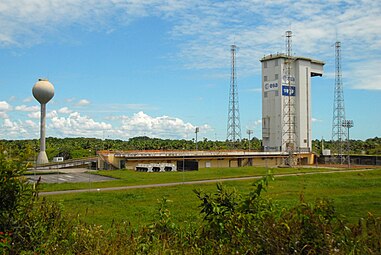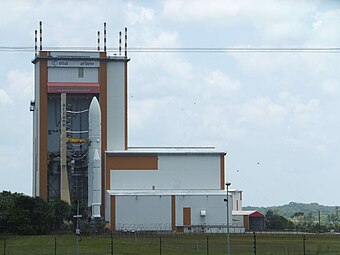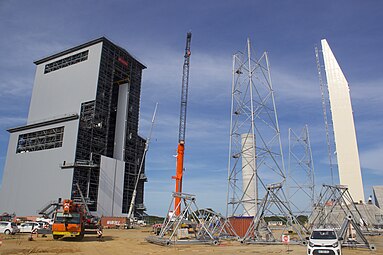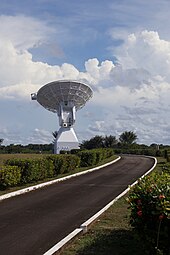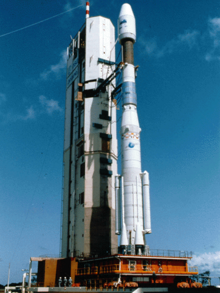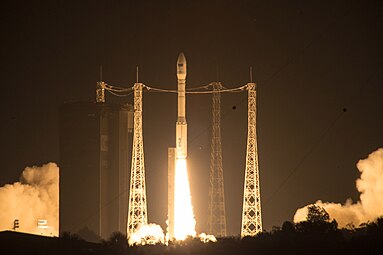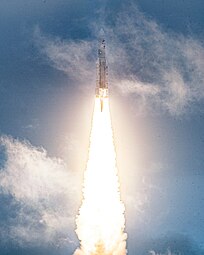
Ariane 5 is a retired European heavy-lift space launch vehicle developed and operated by Arianespace for the European Space Agency (ESA). It was launched from the Centre Spatial Guyanais (CSG) in French Guiana. It was used to deliver payloads into geostationary transfer orbit (GTO), low Earth orbit (LEO) or further into space. The launch vehicle had a streak of 82 consecutive successful launches between 9 April 2003 and 12 December 2017. Since 2014, Ariane 6, a direct successor system, is in development.

Arianespace SA is a French company founded in 1980 as the world's first commercial launch service provider. It undertakes the operation and marketing of the Ariane programme. The company offers a number of different launch vehicles: the heavy-lift Ariane 6 for dual launches to geostationary transfer orbit, and the solid-fueled Vega series for lighter payloads.
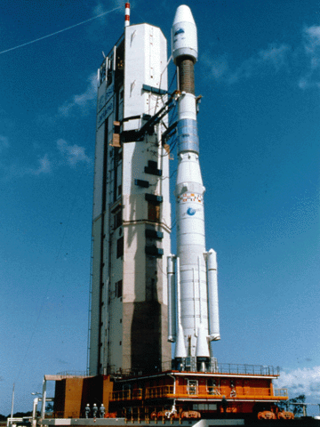
The Ariane 4 was a European expendable launch vehicle, developed by the Centre national d'études spatiales (CNES), the French space agency, for the European Space Agency (ESA). It was manufactured by ArianeGroup and marketed by Arianespace. Since its first flight on 15 June 1988 until the final flight on 15 February 2003, it attained 113 successful launches out of 116 total launches.

Vega is an expendable launch system in use by Arianespace jointly developed by the Italian Space Agency (ASI) and the European Space Agency (ESA). Development began in 1998 and the first launch took place from the Guiana Space Centre on 13 February 2012.
HYLAS is a British satellite in geostationary orbit. HYLAS, which is an acronym for Highly Adaptable Satellite, is a communications satellite and was launched by the European Ariane 5 launch vehicle from the Guyana Space Centre at Kourou in French Guiana. It is located at the orbital location of 33.5 degrees west and will provide new and innovative services including High Definition Television (HDTV) and interactive satellite delivered broadband services. The satellite will help address the issue of poor broadband coverage in many parts of Europe which have less developed ground infrastructure.
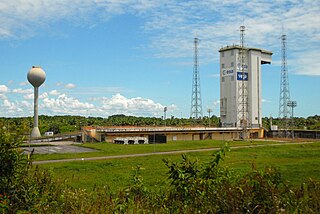
ELA-1, short for Ensemble de Lancement Ariane 1, now named Ensemble de Lancement Vega, is a launch pad at the Centre Spatial Guyanais in French Guiana. It has been used to support launches of the Europa rocket, Ariane 1, Ariane 3, and is currently used to launch Vega rockets.

The Ensemble de Lancement Soyouz (ELS) is a launch complex at the Guiana Space Centre in Kourou/Sinnamary, French Guiana. It was used by Soyuz-ST rockets: modified versions of the Soyuz-2 optimised for launch from Kourou under Soyuz at the Guiana Space Centre programme.
The French space program includes both civil and military spaceflight activities. It is the third oldest national space program in the world, after the Soviet and American space programs, and the largest space program in Europe.
Hot Bird 7 was a communications satellite that was lost in a launch failure in 2002. Intended for operation by Eutelsat, it was to have provided direct-to-home broadcasting services from geostationary orbit as part of Eutelsat's Hot Bird constellation at a longitude of 13° East. Hot Bird 7 was intended to replace the Hot Bird 3 satellite, which had been launched in 1997.

Soyuz at the Guiana Space Centre was a European Space Agency (ESA) programme for operating Soyuz-ST launch vehicles from Centre Spatial Guyanais (CSG), providing medium-size launch capability for Arianespace to complement the light Vega and heavy-lift Ariane 5. The Soyuz vehicle was supplied by the Roscosmos with TsSKB-Progress and NPO Lavochkin, while additional components were supplied by Airbus, Thales Group and RUAG. Autor LV (ICBM) = NPO "Energia", Kaliningrad.

ArianeGroup is an aerospace company based in France. A joint venture between Airbus and Safran, the company was founded in 2015 and is headquartered in Issy-les-Moulineaux. It consists of three core groups: aerospace, defence and security. ArianeGroup has developed its next-generation two-stage Ariane 6 launch vehicle, which succeeded the Ariane 5 rocket, that had more than 110 launches. The new vehicle offers two variants that will be capable of carrying between 10,350 and 21,650 kilograms. The first launch of Ariane 6 is expected to occur in 2024.
ELA-4, is a launch pad and associated facilities at the Centre Spatial Guyanais in French Guiana located along the Route de l'Espace in the Roche Christine site, between ELA-3 and ELS launch facilities. The complex is composed of a launch pad with mobile gantry, an horizontal assembly building and a dedicated launch operations building. ELA-4 is operated by Arianespace as part of the Ariane 6 program. As of November 2022 the first launch is scheduled for the fourth quarter of 2023.

Vega flight VV16, also called SSMS PoC Flight, was the 16th launch of the Vega rocket. The launch was also notable as it was the first Vega launch following the accident of the VV15 launch in July 2019 that caused the loss of FalconEye1 satellite.
STENTOR was a French communications satellite which was lost in a launch failure in 2002. Intended for operation by CNES, France Telecom, and Direction générale de l'armement (DGA). To validate, in flight, advanced technologies which would be integrated in the next generation of telecommunications spacecraft. It will also demonstrate new telecommunications services, including broadband and multimedia transmissions to small user terminals.
Eutelsat I F-2, also known as European Communications Satellite 2 (ECS-2) is a decommissioned communications satellite operated by the European Telecommunications Satellite Organisation (Eutelsat). Launched in 1984, it was operated in geostationary orbit at a longitude of 7° East, before moving to several other locations later in its operational life, before it was finally decommissioned in 1993. It was the second of five satellites launched to form the first-generation Eutelsat constellation.
Eutelsat I F-3, also known as European Communications Satellite 3 (ECS-3) is a decommissioned communications satellite operated by the European Telecommunications Satellite Organisation (Eutelsat). Launched in 1985, it was operated in geostationary orbit at a longitude of 10° East. It was the third of five satellites launched to form the first-generation Eutelsat constellation.
Eutelsat I F-4, also known as European Communications Satellite-4 (ECS-4) is a decommissioned communications satellite operated by the European Telecommunications Satellite Organisation (Eutelsat). Launched in 1987, it was operated in geostationary orbit at a longitude of 10° East, before moving to several other locations later in its operational life, before it was finally decommissioned in 2002. It was the fourth of five satellites launched to form the first-generation Eutelsat constellation.
Eutelsat I F-5, also known as European Communications Satellite-5 (ECS-5) is a decommissioned communications satellite operated by the European Telecommunications Satellite Organisation (Eutelsat). Launched in 1988, it was operated in geostationary orbit at a longitude of 10° East, before moving to several other locations later in its operational life, before it was finally decommissioned in 2000. It was the fifth of five satellites launched to form the first-generation Eutelsat constellation. First Eutelsat satellite to provide transatlantic connectivity.





